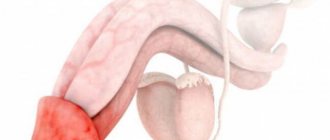Red spots and small rashes on the head of the penis can be the main symptoms of many diseases. Often such rashes are the only thing that bothers a man.
The most common cause is balanitis (inflammation of the head of the penis). Less commonly - dermatological diseases, allergic reactions, oncology.
Table 1 - Main causes of symptoms
| Infectious | |
| Bacterial infection (nonspecific balanoposthitis) | Streptococci, staphylococci, Gardnerella vaginalis |
| Protozoal infection | Trichomoniasis |
| Viruses | Papillomaviruses, genital herpes |
| Fungi | Candidiasis |
| Non-infectious | |
| Benign dermatoses | Plasmacytic balanitis Circinar balanitis Lichen planus Psoriasis |
| Precancerous conditions | Bowenoid papulosis Erythroplasia Queyrat |
| Penis cancer | |
| Taking a number of medications (salicylates, warfarin, etc.) | |
| Mechanical injury | |
| Allergic balanitis | |
Candidiasis
Infection of a man with Candida fungi usually occurs during unprotected sexual intercourse with a woman suffering from thrush. The disease develops over several days and is accompanied by redness of the head of the penis, the appearance of small red dots or, conversely, red spots with a whitish coating, itching (optional), dryness and flaking.
A man may be bothered by swelling of the head, difficulty and pain when retracting the foreskin, discomfort during sex and pain when urinating. Candidiasis balanoposthitis is well treated with local antifungal drugs (ointments and creams based on clotrimazole, miconazole).
In addition, daily genital hygiene, changing underwear, and abstaining from sex during the treatment period are recommended. If the infection persists and relapses frequently, it is necessary to exclude diabetes mellitus (glucose profile, glucose tolerance test, determination of glycated hemoglobin level), immunodeficiencies and STIs.
How to treat?
A qualified specialist will help you cope with redness of the head of the penis, as well as other alarming symptoms. The doctor will examine the genital organs, prescribe tests and develop a treatment regimen taking into account the results of diagnostic measures. If symptoms are caused by urethritis, antibacterial and anti-inflammatory drugs are indicated. If diverticula are involved, surgery may be required.
To make an appointment with a urologist, call the phone number listed on the website. The cost of the clinic's services is shown in the price list. Find out more information at your in-person appointment.
Genital herpes
This is a viral infection transmitted from an infected person during unprotected sex and is most common among young men 14-49 years old. Infection often occurs from a virus carrier who has no symptoms. The first signs may appear several weeks after infection and include fever, general weakness, and decreased vitality.
First, red spots appear on the head, on which, after a few hours, vesicular rashes filled with clear liquid appear. At the moment of their appearance, a man may feel pain and burning, they often itch.
The blisters burst and turn into superficial erosions (similar to herpes on the lips). They become crusty and gradually heal. Therapy includes the prescription of antiviral drugs: acyclovir, valacyclovir or famciclovir.
Papillomas and condylomas
Papillomas and genital warts are benign neoplasms that occur when infected with papillomavirus. It is transmitted during sex (oral, vaginal, anal). The maximum incidence is recorded at the age of 15-25 years among sexually active persons.
The first signs of the disease appear several weeks or months after infection. Papillomas are pink, dome-shaped protrusions of skin. The growths may be flesh-colored, red, or brown. Genital warts with their growths resemble cauliflower.
Formations can occur on the shaft of the penis, foreskin, scrotum, perineal skin and around the anus. In most cases, their appearance is not accompanied by any symptoms; less often, a man may be bothered by itching and discomfort.
Treatment is complex and includes removal of tumors using local drugs or surgical microsurgery and systemic immunotherapy (Panavir, Interferon-alpha).
Rice. 1 – Multiple genital warts of the glans penis
The discussion of the results
During the study, doctors studied data from clinical observation and histological analysis of 41 patients with genital melanosis. In 22 patients, the formations had several colors; in 11 patients they were more than 1.5 cm.
Researchers considered the average age of onset of this condition to be one of the clinical signs of benign genital melanosis. Among the study participants, it was 41 years. Genital melanoma develops on average in the sixth decade of life.
The researchers concluded that it is necessary to avoid unnecessary surgical intervention for genital melanosis. Clinicians consider it necessary to excise and send for histological examination all formations that seem suspicious to them. In the case of genital melanosis, this approach is not necessary. Most of the lesions examined during the study with clinical atypia, such as multiple colors and larger than 1.5 cm in size, were found to be benign.
Excisional biopsy in the genital area not only causes discomfort for the patient. The operation can harm sexual health and disrupt urinary function. The cosmetic result of the operation may be unfavorable.
Researchers have found that in most cases of genital melanosis, it is sufficient to actively monitor patients. Only one of the 41 study participants had both genital melanosis and genital melanoma. In this patient, genital melanosis was discovered almost 11 years after the diagnosis of vulvar melanoma. The formation was excised, and according to the results of histological examination it was recognized as benign.
During 30.5 months of follow-up, none of the study participants developed genital melanoma due to genital melanosis. In 19 patients who came for examination, the formations stabilized, decreased or disappeared. One patient was diagnosed with recurrence of genital melanosis after excision of the lesion.
Based on these data, the researchers concluded that the risk of genital melanosis transforming into melanoma is so small that it is difficult to measure.
The incidence of genital melanosis in the population is unknown. According to studies [1, 2], this condition occurs in 0.011% of patients who come to see a dermatologist. The incidence of genital melanoma is 0.19 cases per 1 million men and 1.8 cases per 1 million women. [4]
The study found that 15% of the experiment participants had a history of melanoma. In only one out of five cases the tumor was found in the genital area. The average age of patients with melanoma was 39 years.
Scientists have confirmed an increased incidence of genital melanosis in patients with a history of melanoma. Such patients have a suprabasal distribution of melanocytes, as well as an increased number of melanocytes in the epidermis.
Genital melanosis with clinical signs of atypia is recognized as an indication for active monitoring of patients, including examination of the whole body with a dermatoscope. However, according to the study, genital melanosis cannot be considered a precursor to genital melanoma. Therefore, in most cases, in patients with genital melanosis, radical surgery with excision of formations is not indicated.
Contact dermatitis
The appearance of red dots on the head may be a sign of contact dermatitis (simple or allergic). Allergies can develop to almost any known chemical substance.
Most often, the reaction occurs to spermicides (components in contraceptives), lubricants, washing powders, men's shower gels, and soap. Contact dermatitis can also develop when wearing tight, synthetic underwear, after violent or prolonged sex (especially if the vulva and vagina of the partner are dry).
In addition to redness and a small rash, a man is bothered by moderate pain, dry skin and swelling. The described symptoms disappear by limiting contact with the allergen, prescribing sexual rest and prescribing reparative ointments (Dexpanthenol, Bepanten). Allergic reactions are quickly relieved by ointments with glucocorticoids (Advantan, Elokom, etc.)
Plasmacytic (Zoon) balanitis
Rice. 2 – Zoon-balanitis
A benign non-venereal disease of the penis, which is characterized by the appearance of a single red-orange, well-circumscribed plaque on the head. It most often develops in middle-aged and elderly men who have not undergone circumcision.
The exact cause of the pathology has not been established, but the main predisposing factors are phimosis, constant irritation and mechanical damage to the skin.
Apart from the plaque, a man may not be bothered by anything; pain and burning during urination are less likely to occur. Circumcision eliminates the manifestations; local ointments based on glucocorticosteroids and 5% imiquimod are also used in treatment.
Circinar balanitis
It occurs in 12-70% of men with Reiter's syndrome (inflammation of the urethra, joints, conjunctiva of the eye due to chlamydia) and is characterized by the appearance of well-demarcated, moist, red spots with an uneven contour on the head of the penis.
In circumcision patients, the lesions have a dry, scaly surface and can mimic psoriasis lesions. Most often, the skin around the external opening of the urethra is involved in the pathological process.
Rice. 3 – Circinar balanitis
Treatment methods
Red spots and dots on the head of the penis should be considered a sign of pathology. The appearance of dots on the head of the genital organ can be caused by the herpes virus, weakened immunity, or infection with gonococci. It is difficult to understand the situation; doctors advise paying attention not only to the treatment of the disease, but also to prevention.
How to treat the patient and what medications he should take if red spots and dots appear on the foreskin should be determined by the doctor. In some cases, complex therapy is required using:
- antibacterial drugs (used in the treatment of syphilis);
- antiviral medications (prescribed for genital herpes);
- antifungal tablets and creams (for the treatment of thrush and candidiasis);
- means that stimulate the activity of the human immune system (vitamins, special additives, immunostimulants).
The doctor will determine how to take the medicine and what kind of medicine it may be. He will develop an individual dosage regimen, determine the dosage and duration of treatment.
How to relieve unpleasant symptoms at the initial stage:
- You can take a warm bath with soda and a decoction of the string.
- Use antiseptics (Chlorhexidine, Miramistin, hydrogen peroxide).
- Apply an emollient (cream or ointment) to the head of the penis.
Baking soda will help you cope with itching and allergies. It is necessary to pour boiling water over several spoons, cool, and then rinse the genital organ in the resulting solution.
Treatment largely depends on the cause of the disease. It can take place in a hospital setting or on an outpatient basis. Hospitalization of a patient is considered a manifestation of last resort and is carried out only in exceptional cases.
After completing therapy, you will have to take tests again. The results will help determine whether the treatment was chosen correctly.
What medications can the doctor prescribe?
- Trichopolum is a drug with antibacterial and antiprotozoal action. Used in the treatment of infectious diseases of the genital area.
- Penicillin - today this antibiotic is rarely used, but in the treatment of syphilis it is the drugs of this class that are most effective.
- Pimafucin - the drug is available in the form of suppositories and cream and is used to treat fungal diseases such as thrush or candidiasis.
- Interferon and drugs based on it are used to treat viral diseases and improve the functioning of the immune system.
- Antiseptic solutions are used for hygiene procedures and help increase the effectiveness of drug therapy.
It is also recommended during the treatment period:
- Stop drinking alcohol.
- Eat properly.
- Maintain intimate peace.
Such therapy is perceived as auxiliary and helps stabilize the patient’s general condition. Treatment for red spots, dots and rashes on the head of the penis in men varies. If alarming signs appear, you should consult a urologist; the doctor will also help you understand the intricacies of drug therapy.
Psoriasis
Psoriasis is a chronic disease. The lesions appear as well-demarcated areas of bright red color with flakes of exfoliated skin.
The process can involve both individual areas of the penis and the entire skin of the perineum. The diagnosis is usually established after examination by a dermatologist (typical signs are the psoriatic triad, localization of plaques, progressive nature of the disease).
The treatment is combined, long-term, and includes mandatory correction of lifestyle and nutrition, local use of glucocorticoids, salicylates, ultraviolet radiation and other techniques.
Rice. 4 - Psoriatic rash on the penis
Symptoms
As a rule, peeling skin on the penis is not the only sign of problems in the body. The symptom is often accompanied by:
- irritation and itching,
- an increase in local and general temperature,
- redness of the skin,
- pathological discharge from the urethra,
- the appearance of wounds or skin blisters,
- the appearance of cracks and excessive dryness,
- pain in the genital area,
- swelling of the inguinal lymph nodes.
If a man experiences the above symptoms or the skin on the penis peels off for a long time, he should definitely consult a doctor. Only a doctor can make a correct diagnosis after a comprehensive diagnosis.
Lichen planus
In approximately 25% of patients, the skin of the penis may also be involved in the process. The head is most often affected: pale pink or violet-pink papules with a flat surface and shine are identified on it.
They tend to merge and form round or ring-shaped plaques. Scales are visible on their surface, and when treated with vegetable oil, dots and stripes appear (Wickham's symptom).
Usually, rashes are found on other parts of the body: torso, arms, forearms, legs, and in the mouth. In rare cases, ulceration occurs.
The diagnosis is based on examination data; if there is doubt about the diagnosis, a biopsy of the papules is performed.
Rice. 5 – Lichen planus
Methods
The study involved 41 patients with genital melanosis. The criterion for participation was the presence of a mass larger than 1 cm or multiple associated lesions whose total size exceeded 1 cm.
The patients were divided into two groups according to the size of the formation. The first included participants with formations larger than 1.5 cm, the second included participants with formations less than 1.5 cm.
Biopsies were performed in 35 of the 41 patients. During the histological examination, pathologists assessed, among other things, the following data:
- The number of melanocytes per square millimeter of the epidermis.
- Presence of nuclear atypia.
- Location of melanocytes in the epidermis.
Five patients were biopsied multiple times. Samples with the highest number of melanocytes per square millimeter of epidermis were used for overall statistical analysis.
Taking medications
The appearance of red dots and spots on the head may be associated with constant use of antibiotics (especially tetracycline, sulfonamides), salicylates, Phenacetin, Co-trimoxazole and some other drugs.
The rashes have a clearly defined round or oval shape and a bright red color; a bubble of liquid may form in the center of the spot.
In most cases, discontinuation of the drug leads to gradual resolution of the rash. Sometimes the prescription of glucocorticoid ointments is required. Healing is accompanied by the formation of pigment spots.
Redness of the head and foreskin: causes
One of the most common pathologies is infectious lesions of the genitourinary system.
Today, most males suffer from them.
In addition to sexually transmitted diseases, the causes of redness of the genital organ are:
- 1. Injuries;
- 2. Inflammatory processes;
- 3. Rubbing;
- 4. Allergies.
If redness of the head or foreskin appears, the causes and treatment can be varied.
If redness appears on the head, this may be a signal of an infection.
Such diseases include:
- Gonorrhea;
- Trichomoniasis;
- Chlamydia.
Redness and pain of the head in such diseases is one of the leading symptoms.
In this case, burning and itching occurs.
You can often notice the presence of hyperemia on the head of the genital organ.
Let's take a closer look at what causes the appearance of redness and itching on the head of the penis.
Redness on the head due to rubbing
Rubbing the genitals is quite easy.
At the same time, various unpleasant symptoms begin to be felt.
A man may feel a burning sensation and swelling in the foreskin area.
Redness of the mucous membrane and skin of the penis appears.
After some time, small bubbles appear followed by the formation of erosions.
There are several reasons for the appearance of unpleasant symptoms.
Mechanical damage can occur as a result of prolonged sexual intercourse or masturbation.
Chafing of the penis can be noticed after sexual intercourse.
If there are no pathological processes, then the skin of the penis will be slightly hyperemic with slight swelling.
In this case, transparent discharge will appear.
The problem may occur due to insufficient lubrication.
Another reason for the appearance of chafing may be poor-quality synthetic underwear.
Wearing such underwear leads to skin irritation.
Failure to comply with hygiene rules contributes to the growth of bacteria.
As a result, redness and itching appears.
Chafing of the penis brings a lot of discomfort.
This condition should normally go away after a few hours.
There are cases when the symptoms are pathological and require immediate treatment.
Pathological signs include:
- 1. The presence of an unpleasant odor;
- 2. Painful excretion of urine;
- 3. Presence of redness and ulcers.
If such signs appear, it is recommended to shave and see a doctor.
Redness on the head due to allergies
Often the cause of redness at the tip of the head is an allergic reaction.
Appears when the genital organ is exposed to allergens.
One of the reasons is the use of various lubricants, creams and lotions.
Medicines can also have an effect on the penis.
The appearance of redness on the head of the penis may be a consequence of the administration of vitamins and vaccines.
How to distinguish allergies?
When exposed to skin, erythema appears, which is the formation of red spots on the skin of the penis.
Symptoms develop very quickly.
After using antihistamines, itching and other symptoms disappear.
After some time, the rashes disappear, leaving no traces behind.
If the reaction is severe, medical attention may be needed.
It is recommended to consult a doctor if the symptoms persist.
If personal hygiene is not carried out regularly, allergies will not be long in coming.
This occurs due to the fact that secretions begin to accumulate in the foreskin, provoking the proliferation of bacteria.
If the head itches and redness appears, it is necessary to identify the allergen and limit its effect on the genital organ.
Redness on the head may occur when using hormonal ointments.
You should not use these drugs for a long time and without a doctor's prescription.
If a reaction occurs, you should see a doctor.
Redness on the head due to an STD
The appearance of redness, itching of the glans and foreskin is a sign of sexually transmitted infections.
Often the cause of transmission of an infectious agent through sexual contact will be a defect in the mucous membrane.
The onset of symptoms causes severe discomfort.
There are a number of reasons for the appearance of blisters, redness and itching of the head of the penis.
These include:
- Injury to mucous membranes and skin;
- Inflammatory processes;
- Disturbances in the functioning of the endocrine system;
- Narrowing of the foreskin.
The appearance of a white coating and redness on the head may be the result of unprotected sexual intercourse.
Infection occurs from a sexual partner.
The presence of such signs is a consequence of infection with one of the diseases:
- 1. Trichomoniasis;
- 2. Gonorrhea;
- 3. Chlamydia;
- 4. Genital herpes;
- 5. Gardnerellosis;
- 6. Mycoplasmosis;
- 7. Candidiasis.
When infectious agents are introduced, an infectious process begins to develop.
There is a problem with urination.
The appearance of discharge of various types is noted.
Attention! For each disease, the discharge will have a characteristic color and consistency.
Sometimes severe rashes appear in the groove.
This is typical when affected by herpes.
Precancerous conditions
10.1. Bowenoid papulosis
The disease develops against the background of infection with papillomavirus types 16, 18, 34, 39, 40, 42, 45. Rashes in the form of papules, multiple, small, appear on the head and foreskin and gradually merge into one large, flat plaque, their color is red-brown or gray-brown. Bowenoid papulosis can transform into cancer.
The main method of treatment is surgical excision/cauterization of the affected areas (CO2 laser, cryodestruction).
10.2. Erythroplasia Keira
Malignant tumor of the head of the penis in situ (non-invasive tumor). The foreskin may also be involved in the pathological process (single or multiple red neoplasms with clear edges are detected on the skin).
The disease affects men who have not undergone circumcision. Over time, the tumor may grow deeper into the tissue. The main treatment is surgical excision. The patient is also recommended to undergo circumcision.
Squamous cell skin cancer of the penis
This form accounts for 95% of all malignant tumors of the penis. Peak incidence is 40-50 years. Risk factors are phimosis, balanitis obliterans and other precancerous conditions, frequent change of sexual partners, infection with HPV types 16 and 18.
Squamous cell carcinoma practically does not occur in men after circumcision. Red, compacted areas with unclear contours may appear on the skin of the head; in some cases, the tumor protrudes significantly above the skin.
Tumor germination is accompanied by superficial ulceration and bleeding. Examination and treatment are prescribed by an oncologist. The treatment regimen depends on the stage of the tumor and may include surgical excision, radiation, chemotherapy, or laser removal of the tumor.
Rice. 6 – Squamous cell carcinoma of the head of the penis
Prevention
As part of preventive procedures, doctors recommend:
- Take vitamins 2 times a year to strengthen your immune system.
- Use barrier contraception.
- Wear underwear and clothes made from natural fabrics (cotton).
- Follow the rules of hygiene, take a shower and change your underwear once a day.
- Visit a doctor once every 6 months for preventive examinations.
- Take tests and undergo scheduled diagnostic procedures once a year (including donating blood for ELISA, RIT and RIF, and for the Wasserman test).
Notifying partners about the presence of certain diseases of the intimate area can be regarded as prevention or treatment. Since therapy for some diseases is carried out in patients simultaneously.










